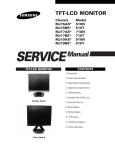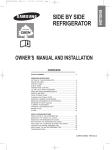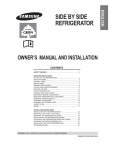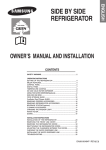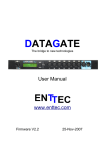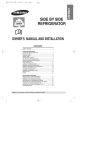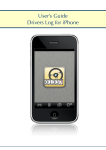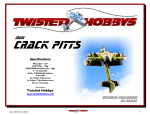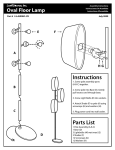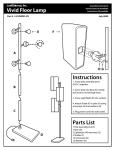Download Samsung RS User's Manual
Transcript
RS Write the model and serial number here: Model # Serial # Find these numbers on a label of the refrigerator cabinet at the left hand-side wall. OWNER’S MANUAL AND INSTALLATION Before operating the appliance, please read this manual carefully and retain for future reference. CONTENTS SAFETY WARNING SIGNS ........................................................... 2 OPERATING INSTRUCTIONS ..................................................... 4 PREPARING THE APPLIANC FOR USE ............................................ 4 FEATURES ................................................................................................ 4 THE CONTROL PANEL ............................................................................ 5 DIGITAL PANEL ........................................................................................ 5 THE CONTROL PANEL ............................................................................ 6 TEMPERATURE CONTROL .................................................................... 6 OVERVIEW OF YOUR FREEZER/REFRIGERATOR ....................... 7 MAKING ICE ............................................................................................ 7 FOOD STORAGE GUIDE ........................................................................ 8 REMOVING ACCESSORIES FROM THE FREEZER ...................... 10 REMOVING ACCESSORIES FROM THE REFRIGERATOR .......... 10 CLEANING THE ACCESSORIES ......................................................... 11 REPLACING THE LIGHTBULBS .......................................................... 11 INSTALLATION INSTRUCTIONS ............................................. 12 INSTALLATION OF THE REFRIGERATOR ........................................... 12 ADJUSTING THE CLEARANCE BETWEEN THE DOORS ............ 14 TROUBLESHOOTING ........................................................................... 15 DA68-01171A REV(0.2) ENGLISH SIDE BY SIDE REFRIGERATOR SAFETY WARNINGS • Before operating the appliance, please read this manual thoroughly and retain it for your reference. • Because these following operating instructions cover various models, the characteris tics of your refrigerator may differ slightly from those described in this manual WARNING • The appliance is not intended for use by children or infirm persons without adult supervision. • Children should be supervised to ensure that they do not play with the appliance. • R600a or R134a is used as a refrigerant. Check the compressor label on the rear of the appli • The refrigerant used in the refrigerator/freezer and the gases in the insulation material require special disposal procedures. Ensure that none of the pipes on the back of the appliance are damaged prior to disposal. CAUTION/WARNING SYMBOLS USED OTHER SYMBOLS USED Represents something you must NOT WARNING Represents something you must NOT disassemble. Represents something you must NOT touch. Indicates that a danger of death aor serious injury exists. Represents something you must follow. CAUTION Indicates that you must disconnect the power plug from the socket. Represents a ground is needed to prevent electric shock. It is recommended that this symbol be handled by service man. Indicates that a risk of personal injury or material damage exists. WARNING Do not plug several appliances into the same multiple power board. • This could cause overheating and the risk of fire. Make sure that the power plug is not squashed or damaged by the back of the refrigerator . • A damaged power plug may overheat and cause fire. Do not bend the power cord excessively or placeheavey articles on it . • This constitutes a fire hazard. If the power cord is damaged, have it replaced immediately by the manufacturer or its service agent. Do not directly spray water inside or outside the refrigerator. • There is a risk of fire or electric shock. Do not spray inflamable gas near the refrigerator. • There is a risk of explosion or fire. Do not insert the power plug with wet hands. • You may receive an electric shock. Do not put a container filled with water on the refrigerator. • If spilled, there is a risk of fire or electric shock. Do not install the refrigerator in a damp place or a place where it may come in contact with water. • Deteriorated insulation of electrical parts may cause an electric shock or fire. Do not store volatile or flammable substances in the refrigerator. • The storage of benzene, thinner, alcohol, ether, LP gas and other such products may cause explosions. Do not disassemble or repair the refrigerator by yourself. • You run the risk of causing a fire, malfunctions and/or personal injury. Pull the power plug out of the socket before changing the interior light of the refrigerator. • Otherwise, there is a risk of electric shock. If you wish to dispose of the refrigerator / freezer throw it away after first removing the doors and seals. • Do so in a way, that is not possible for a child to remain trapped inside. The refrigerator must be grounded. • You must ground the refrigerator to prevent any power leak ages or electric shocks caused by current leakage from the refrigerator. Never use gas pipes, telephone lines or other potential lightening rods as ground. • Improper use of the ground plug can result in electric shock. WARNING • Keep ventilation openings in the appliance enclosure or mounting structure clear of obstruction. • Do not use mechanical devices or any other means to accelerate the defrosting process, other than those recommended by the manufacturer. • Do not damage the refrigerant circuit. • Do not use electrical appliances inside the refrigerator/freezer, unless they are of a type recommended by the manufacturer. 2 WARNING CAUTIONS Do not overfill the refrigerator with food. • If food falls out when you open the doors, there is a risk of personal injury and or material damage. The refrigerant used in the refrigerator/freezer and the gases in the insulation material require special disposal procedures. Ensure that none of the pipes on the back of the appliance are damaged prior to disposal. Do not put bottles or glass containers in the freezer. • When the contents freeze, the glass may break and cause personal injury. If the power plug socket is loose, do not insert the power plug. • There is a risk of electric shock or fire. Do not disconnect the power cord by pulling on its lead. • Damage to the cord may cause a short-circuit, fire and or electric shock. Do not use a wet or damp cloth when cleaning the plug. Remove any foreign matter or dust from the power plug pins. • Otherwise there is a risk of fire. • If the refrigerator is disconnected from the power supply, you should wait for at least five minutes before plugging it back. • If the power cord is damaged, it must be replaced by the manufacturer, a certified service agent or qualified service personnel. If the refrigerator is not to be used for a long period of time, pull out the power plug. • Deterioration in the insulation may cause fire. Do not store articles on top of the appliance. • When you open or close the door, the articles may fall and cause personal injury and or material damage. The appliance is not intended for use by young children or infirm persons without supervision. Young children should be supervised to ensure that they do not play with the appliance. Do not store medicine, scientific materials and temperature-sensitive products in the refrigerator. • Check product labels to make sure that refrigeration is not prohibited. Do not place the equipment directly under the sunlight. Do not let children hang on the doors. The appliance must be positioned so that the plug is accessible after installation If you detect abnormal sounds, smzells or smoke, pull out the power plug immediately and contact your nearest SAMSUNG Electronics service center. If the power cord is damaged it must be replaced by manufacturer, a certified service agent or qualified service personnel. Do not place your hands in the area under neath the appliance. • Any sharp edge may cause personal injury. This appliance contains a small amount of isobutane refrigerant (R600a), a natural gas with high environmental compatibility that is, however, also combustible. When transporting and installing the appliance, care should be taken to ensure that no parts of the refrigerating circuit are damaged. Do not touch the inside walls of the freezer or products stored in the freezer with wet hands. • It may cause frostbite. Do not use a wet or damp cloth when cleaning the plug. Remove any foreign matter from the power plug pins. • There is a risk of burning and fire. Refrigerant squirting out of the pipes could ignite or cause an eye injury. If a leak is detected, avoid any naked flames or potential sources of ignition and air the room in which the appliance is standing for several minutes. • In order to avoid the creation of a flammable gas-air mixture if a leak in the refrigerating circuit occurs, the size of the room in which the appliance may be sited depends on the amount of refrigerant used. The room must be 1m3 in size for every 8 g of R600a refrigerant inside the appliance. The amount of refrigerant in your particular appliance is shown on the identification plate inside the appliance. • Never start up an appliance showing any signs of damage. If in doubt, consult your dealer. If you wish to move the freezer/refrigerator, hold it by the handles on its back and bottom . • If the appliance is disconnected from the power supply, you should wait for at least five minutes before plugging it back in. If the freezer/refrigerator will not be used for a long period of time, pull out the power plug. • Any deterioration in the insulation may cause fire. 3 SAFETY WARNING SIGNS SAFETY WARNINGS PREPARING THE APPLIANCE FOR USE Once you have performed the following steps, your freezer/refrigerator should be fully operational. If not, check the power supply and electricity source. If you have any doubts or problems, contact your nearest SAMSUNG service center. Place the shelves and containers which were removed for transport in their appropriate positions (refer to pages 8 to 9). Set the temperature control to the coldest temperature and wait for one hour. The freezer/refrigerator should now be slightly chilled and the motor should run smoothly producing a soft humming noise. Clean the freezer/refrigerator and accessories to remove any dust that may have accumulated during packing and shipping (refer to page 9). Once the freezer/refrigerator temperature is sufficiently cool, you can begin storing food inside. Please be advised that it takes a few hours after starting the freezer/refrigerator to reach the appropriate temperature. When the refrigerator is plugged in, the interior light should illuminate every time the refrigerator door is opened. FEATURES Multi-Flow System • Cool air circulates through multiple vents on each shelf level. This provides even distribution of cooling inside of freezer/refrigerator and keeps food fresher for longer. High humidity for fresher food • You can keep food, fruit and vegetables fresh for longer because your refrigerator supplies highly humidified cold air. Door alarm • When the refrigerator door is left open for more than two minutes, a musical alarm is automatically triggered. This feature helps you save electricity and preserve stored foods. 4 Power Freezer Speeds up the freezing process in freezer. Power Cool Speeds up the cooling process in fridge Freezer Temp To set the freezer temperature, press the button repeatedly to change the set temperature in sequence between -14ºC and -25ºC Fridge Temp To set the fridge temperature, press the button repeatedly to change the set temperature in sequence between 1 ºC and 7 ºC DIGITAL PANEL Freezer Temp : Indicates the current freezer temperature. Fridge Temp : Indicates the current fridge temperature. Power Freeze • This light is on when you press the Power Freezer button. Press the button to make the freezer reach the set temperature guickly. • Press the button again to cancel the Power Freezer mode. Power Cool • This light is on when you press the Power Cool button. Press the button to make the fridge reach the set temperature guickly. • Press the button again to cancel the Power Cool mode. 5 OPERATING INSTRUCTIONS THE CONTROL PANEL THE CONTROL PANEL FRE. TEMP. BUTTON To set the freezer temperature, push the button repeatedly to select a level between 1 level (cold) to 9 level (colder). • REF. TEMP. BUTTON To set the refrigerator temperature, push the button repeatedly to select a level between 1 level (cold) to 9 level (colder). The higher level you set, the lower temperature inside the unit. NOTE TEMPERATURE CONTROL Freezer Control levels table • The freezer temperature can be set to a level between Reference 1 level (cold) to 9 level (colder). • Push the FRE. TEMP. button repeatedly until the desired level is reached. -.At each level, the LED lamps will turn on or off as shown on the table. cold normal colder LED Condition (on) (off) (blink) level Refrigerator • The refrigerator temperature can be set to a level 1 2 3 4 5 6 7 9 ❋ At level 2,4,6,8 the LED which is marked with ( ) will light up fully ( ) after blinking for 5 seconds. between 1 level (cold) to 9 level (colder). • Push the REF. TEMP. button repeatedly until the desired level is reached. -.At each level, the LED lamps will turn on or off as shown on the table. • For your convenience, your freezer/refrigerator controls have been preset at the factory. The NOTE 8 freezer/refrigerator control should both be set to NORMAL (level 5) when you first install your freezer/refrigdfator. 6 OVERVIEW OF YOUR FREEZER / REFRIGERATOR FREEZER / REFRIGERATOR Light Light Dairy compartment Food Guard Egg tray Food Guard Fresh center (option) Ice tray Fresh fruit & salad drawer (upper) Drawer Fresh salad drawer (lower) Bottle guard Leg cover MAKING ICE Pull out the ice tray. Place it under the freezer shelf or on the freezer shelf. Pour water into the tray until it reaches the water level indicator on the tray. To separate individual ice cubes, pull out the ice tray and hold the ice tray by its ends, then twist it gently. 7 OPERATING INSTRUCTIONS Shelf Shelf FOOD STORAGE GUIDE 8 4 11 5 1 9 2 3 6 3 7 10 FOOD STORAGE GUIDE TO FREEZER Food Guard For storing small packages of frozen food. Tempered glass shelf For storing all types of frozen food. Meat and dry goods storage compartment For storing meat and dry goods. Stored food should be wrapped securely using foil or other suitable wrapping materials. Tempered glass shelf • Can be used safely because it will not break if it falls. Fresh center (option) • Preserve the taste of food and prolongs its freshness. Use the fresh center to store cheese, meat, snacks, fish or any food to be used quickly. 8 FOOD STORAGE GUIDE Fresh fruit & salad drawer (Upper) • Stores fruit. • This compartment preserves freshness for a long period of time by maintaining the moisture in the food. ❈ To create more storage space, simply remove the drawer. Fresh salad drawer (Lower) • Stores vegetable. • This compartment is airtight and maintains the moisture content and fresh- ness of the food for a long time as itmes stored inside are not directly affected by the cooing system of the unit. Dairy compartment Food Guard • Stores such as milk and yoghurt in small packages. Bottle guard • Stores a variety of bottles, cans and cartons. Egg tray • Stores eggs in the egg tray and then place the tray on the tempered glass shelf. • Food stored under ambient temperatures of 5 oC or lower can be frozen. NOTE 9 OPERATING INSTRUCTIONS • Stores fatty foods, like butter and cheese. REMOVING ACCESSORIES FROM THE FREEZER Ice tray and cube • Remove the ice tray by pulling it towards you. Tempered glass shelf • Pull the shelf out as far as it goes. Then lift it up and remove it. Food Guard Leg cover • Hold the guard in both • Open the freezer and refriger- hands and then lift it up. ator doors, remove the three screws and detach the leg cover. • To reassemble the leg cover, replace it in its original position and tighten the three screws. Drawers • Remove the compartment by pulling it out and lifting it up slightly. • • Warning • ❈ Only remove the leg cover when absolutely necessary. Do not use excessive force when removing the accessories, otherwise, it may cause personal injury. Do not place top side shelf of freezer in any other location, it may get dropped, damaged and cause personal injury. Before removing accessories from the freezer and refrigerator always move stored food to other space first. REMOVING ACCESSORIES FROM THE REFRIGERATOR Fresh fruit & salad drawer and lower shelf • Remove the compartment by holding the handle, pulling the compartment towards you and lifting it up slightly. • Remove the lower shelf by pulling it towards you. • Keep the sequence (first, remove fresh fruit salad draw after then remove lower shelf) • Lower shelf can be damaged if you do not keep the sequence. Tempered glass shelf • Pull the shelf out as far as it will go. Then lift it up and remove it. Bottle guards and food guard • Hold the shelf in both hands and remove it by lifting it up. 10 CLEANING THE ACCESSORIES Inside • Clean the accessories using a mild detergent. Then wipe with a dry cloth. • After washing the accessories, make sure that they are dry before using them again. Rear • Use a vacuum cleaner to remove dust once or twice a year. Exterior • The doors and door handles should be cleaned with a mild detergent and cloth. Dry them with a clean cloth. • The exterior should be polished once or twice a year. • When cleaning the appliance or if the appliance will not be used for a long time, allways turn the power off, leave the doors open and keep the appliance dry. Do not clean it by spraying it directly with water. Warning • • Do not clean it with benzene, thinner or car detergent. REPLACING THE LIGHTBULBS WARNING Before replacing the lightbulbs light, unplug the appliance from the power supply. If you experience difficulty when you attempt to replace the lightbulbs contact your nearest samsung service center. LIGHTBULBS Remove the lamp cover. Use the screw driver to remove the screws securing the lamp cover. NOTE After replacing the bulb, reassemble the cover with a screw. The rated wattage of lightbulbs are marked on the lamp cover and lightbulbs. 11 OPERATING INSTRUCTIONS Rubber door seals • If the rubber door seals are dirty, the door will not close properly and the refrigerator and freezer will be unable to function efficiently. Clean them with a mild detergent and damp cloth. Then wipe them with a dry cloth. INSTALLATION OF THE REFRIGERATOR Checking the dimensions of your entrance door Checking the dimensions of your entrance door to determine whether the refrigerator can pass through it. * Dimensions of the appliance Dimensions (mm) Remark Width 850 Dept 724 with door Height 1722 with hinge Allow a clearance of 1 cm to the right, left and rear side when installing the appliance; as this will help to reduce power consumption. Allow sufficient space to install the appliance on a flat surface. • If your appliance is not level, the internal cooling system may not work properly Clean your freezer/refrigerator. • Wipe the inside and outside of your freezer/refrigerator with a dry cloth. Store food in the freezer/refrigerator. • Wait for at least two or three hours after plugging your appliance in before storing food and other items inside. 12 INSTALLATION OF THE REFRIGERATOR LEVELLING When you adjust the level of the freezer/refrigerator, set the front legs slightly higher than the rear legs, so that you can open and close the door more easily. First disassemble the leg cover and then adjust the level of the freezer/refrigerator. If your freezer/refrigerator tilts to the left, turn the left adjusting leg. If your freezer/refrigerator tilts to the right, turn the right adjusting leg. EARTHING THE APPLIANCE WARNING If you are using a power plug that is not already earthed. • Connect one end of the earthing wire (yellow/green or green) to the earth screw and the other end to a steel or copper pipe, such as a water pipe. Earthing wire Copper pipe Earth screw 13 INSTALLATION INSTRUCTIONS The appliance must be earthed before use. You must earth the freezer/refrigerator to prevent any power leakage or electric shock caused by current leakage from the appliance. • Never use gas pipes, telephone lines or other potential lightning rods as earths. ADJUSTING THE CLEARANCE BETWEEN THE DOORS Adjusting the small step difference between doors. If the door of freezer is higher than that of the refrigerator. If the door of freezer is lower than that of the refrigerator. Adjustment part Adjustment part Please open the doors and adjust the doors as follows: 1) Release the nut (①) on the lower hinge until the upper end of the bolt (➁). When you release the nut(①), use enclosed hex wrench (➂) to turn the bolt(➁) a little counterNOTE clockwise to make the nut(①) loose with your fingers. ➂ WRENCH ➂ WRENCH ➀ NUT ➀ NUT ➁ BOLT ➁ BOLT 2) Please adjust the height difference between the doors turning the bolt (➁) turn clockwise( clockwise ( ). When you turn clockwise ( ) or counter ), the door goes up. NOTE ➂ WRENCH ➂ WRENCH ➁ BOLT ➁ BOLT 3) After adjusting the doors, turn the nut (①) turn clockwise( en the bolt again with wrench (➂) to fix the nut(①). ) until the lower end of the bolt, then tight➂ WRENCH ➂ WRENCH ➀ NUT ➀ NUT ➁ BOLT ➁ BOLT If you do not fix the nut (①)firmly, the bolt (➁) may be released. NOTE 14 TROUBLESHOOTING INSTALLATION INSTRUCTIONS The freezer/refrigerator does not work at all or it The front corners and sides of the freezer / does not chill sufficiently refrigerator are hot. • Check that the power plug is properly connected. • Heat pipes are installed in the front corners of the refrigerator to prevent condensation. • Check that the power plug fuse has not blown. • Is the temperature control set to the proper tem- • Condensation can result from leaveing the unit’s door open for too long or storing unwrapped food perature? with a high water content when outside tempera• Is the freezer/refrigerator in direct sunlight or ture and humidity levels are high. located near a heat source? • Is the back of the freezer/refrigerator too close to You can hear water babbling in the refrigerator the wall? • The babbling is caused by the refrigerant circulatThe food in the refrigerator is frozen • Is the temperature control set to the proper tem- ing in the unit. perature? There is a bad smell in the freezer/refrigerator • You did not wrap food with a strong smell proper• Is the temperature in the room too low? ly, or you have left something in the refrigerator • Did you put food with a high water content near for too long. the coldest part of the refrigerator. • Always wrap food with a strong smell so that it is airtight. Always throw away food that has gone You can hear unusual noise or sounds off. • Check that the floor is level and stable. • Is the back of the appliance too near to the wall? Frost forms on the wall of the freezer • Has anything dropped behind or under the appli- • Is the air inlet/outlet blocked? ance? • Always allow sufficient space between the food • Is the noise from the compressor in the appliitems for air to circulate efficiently. ance? • Is the door closed properly? • A “ticking” sound may be heard from inside the appliance, but this is normal. It is caused when the various accessories contract or expand. 15 Ambient Room Temperature Limits This appliance is designed to operate at the ambient temperatures specified by its temperature class marked on the rating plate. Temperature Class Extended Temperate Symbol Ambient Temperature Maximum Minimum SN 32°C (90°F) 10°C (50°F) Temperate N 32°C (90°F) 16°C (61°F) Subtropical ST 38°C (100°F) 18°C (64°F) T 43°C (109°F) 18°C (64°F) Tropical NOTE: The internal temperature may be affected by such factors as the location of the appliance, ambient temperature and the frequency with which you open the doors. Adjust the temperature as required to compensate for these factors.


















